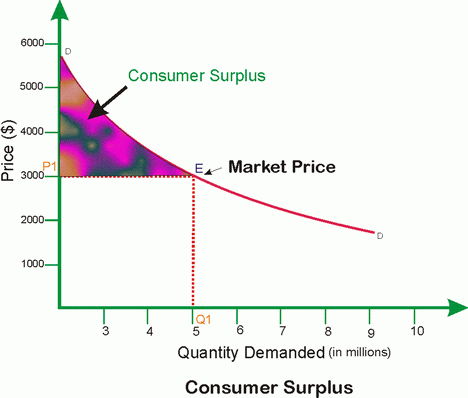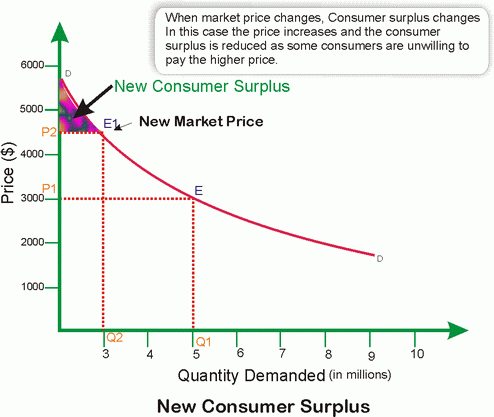Consumer Surplus
The individual consumer surplus is the difference between the maximum total price a consumer would be willing to pay (or reservation price) for the amount he buys and the actual total price.
Example
Suppose you are in Wal-Mart and you see a DVD on the rack. No price is indicated on the package, so you bring it over to the register to check the price. As you walk to the register, you think to yourself that $20 is the highest price you would be willing to pay. At the register, you find out that the price is actually $12, so you buy the DVD. Your consumer surplus in this example is $8: the difference between the $20 you were willing to pay and the $12 you actually paid.If someone is willing to pay more than the actual price, their benefit in a transaction is how much they saved when they didn't pay that price. For example, a person is willing to pay a tremendous amount for water since he needs it to survive, however since there are competing suppliers of water he is able to purchase it for less than he is willing to pay. The difference between the two prices is the consumer surplus.

The maximum price a consumer would be willing to pay for a given amount is the sum of the maximum price he would be willing to pay for the first unit, the maximum additional price he would be willing to pay for the second unit, etc.

Typically these prices are decreasing; in that case they are given by the individual demand curve. If these prices are first increasing and then decreasing there may be a non-zero amount with zero consumer surplus. The consumer would not buy an amount larger than zero and smaller than this amount because the consumer surplus would be negative. The maximum additional price a consumer would be willing to pay for each additional unit may also alternatingly be high and low, e.g. if he wants an even number of units, such as in the case of tickets he uses in pairs on dates.
The lower values do not show up in the demand curve because they correspond to amounts the consumer does not buy, regardless of the price. For a given price the consumer buys the amount for which the consumer surplus is highest.
Download Consumer Surplus handout





